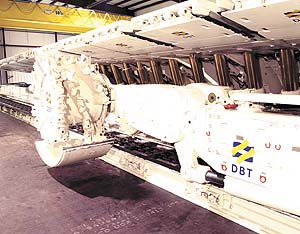| SUFCO mine will install a new longwall system which was built by DBT. |
SUFCO Mine is moving into a new generation of mining technology.
“We are putting in a new longwall,” said Ken May, SUFCO Mine manager. “SUFCO is receiving some of the best technology available.”
Arch Coal Incorporated – SUFCO’s parent company – purchased the new longwall mining system last year. The new system will allow for more efficient extraction of the coal resources available at the SUFCO Mine, May said.
“It’s a tremendous vote of confidence in our operation,” May said. He said the new equipment is a very substantial investment, and will even increase the valuation of the mine. The new equipment is tentatively slated to go into service in mid-February – pending safety inspections. SUFCO’s current longwall mining system is nearly 10 years old.
The system is the third generation of longwall equipment to be used at SUFCO. The company started longwall mining in 1985.
The first generation of roof supports accommodated approximately 17 tons each, as compared to 41.6 tons with the new longwall system. The first longwall was manually operated with simple hydraulics, whereas now it is controlled through a fully electronic control system.
Longwall mining allows for panels of coal to be taken out in large slices.
The new longwall system was purchased from DBT America, and was designed to accommodate higher horsepower, more capacity and wider longwall panels, 1,105 feet. The old mining equipment allowed for a 930-foot wide face.
When the system is fully functional, SUFCO will be able to mine up to 5,000 tons of coal per hour. Last year, the mine produced some 7.9 million tons of coal, May said. This year, the mine is budgeted to produce 7.2 million tons of coal.
The system was ordered in December 2005. It was custom designed and manufactured in 2006, with portions of the machine being completed in both the USA and Germany. The construction of the new equipment culminated in a full scale compatibility test at DBT America’s Huntington facility. The test consisted of a “mini” longwall, with 28 of the 168 roof supports in use.
The new system has a higher support capacity than the present system at SUFCO. The new roof supports 41.6 tons for the face shields and 47 tons for the gate shields. This is approximately 20 percent heavier than what the existing shields are capable of, partly due to the new standard of width – two meters versus 1.75 meters.
The shearer portion of the new apparatus is DBT America’s EL-3000. It is equipped with 1,200 horsepower cutting motors, and has advanced automation to minimize the operators’ exposure to dust. It is designed to cut coal seams ranging from 8 feet to 14 feet. The shearer is equipped with the latest technology, including AC drives and on-board monitoring, and weighs in excess of 90 tons.
The longwall face conveyor system will be equipped in the second panel with three 1,650 HP/4,160 volt electric motors.
“They are some of the largest motors used to drive a longwall in the country,” May said. This will be the highest connected horsepower on any longwall system in the United States. The armored face conveyor system transports the coal at 360 feet per minute, onto a 60-inch wide panel belt. A large rotary crusher, weighing 45 tons and equipped with an 800 HP motor, sizes the coal from large three foot blocks into six-eight inch lumps for ease of transportation on the belt line.
The new longwall system, in total, weighs nearly 8,000 tons. In addition to large ocean vessels that were used to transport the equipment from Germany, specialty trucks capable of hauling 90,000 pounds were used to transport the roof supports. The roof supports were brought into the port of Houston, and then sent by rail or truck to the mine site.
Electronic controls are included on each piece of equipment, which allows the system to be operated remotely, with a minimum number of operators. Extensive training is provided by DBT America to help ensure optimum and safe use of the equipment. SUFCO Mine is located in Salina Canyon and employs several workers from Emery County.

